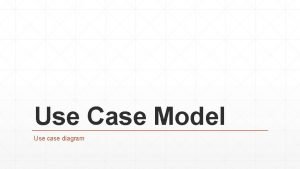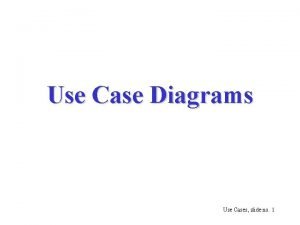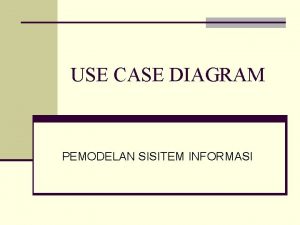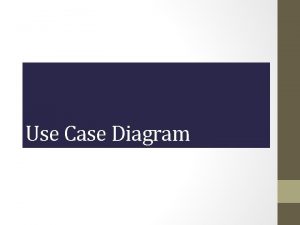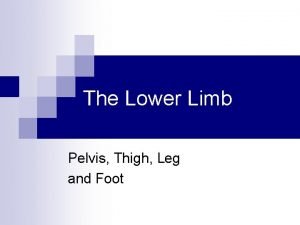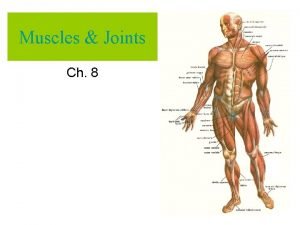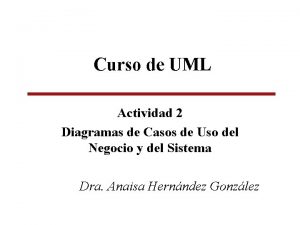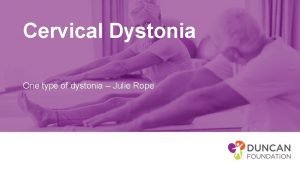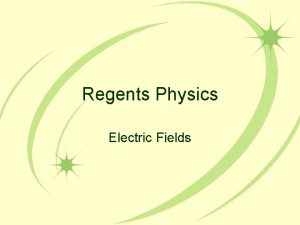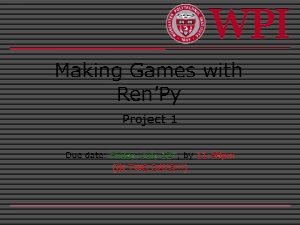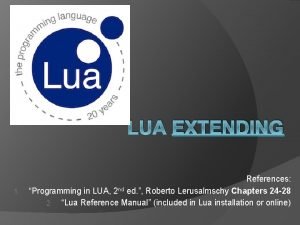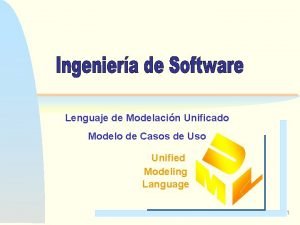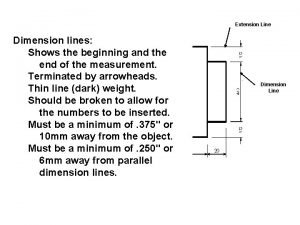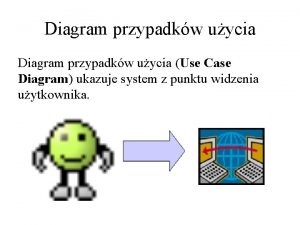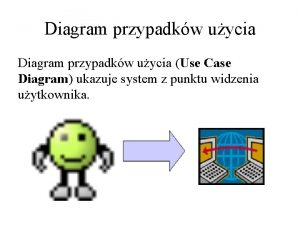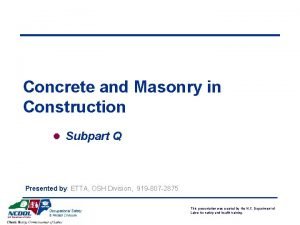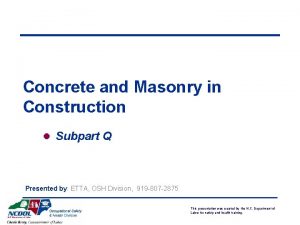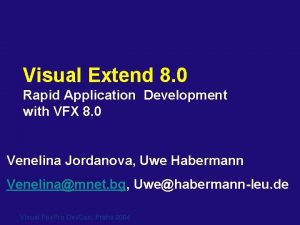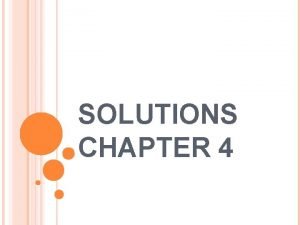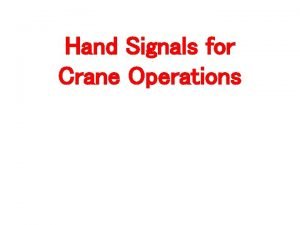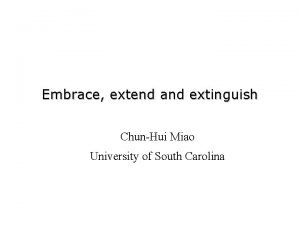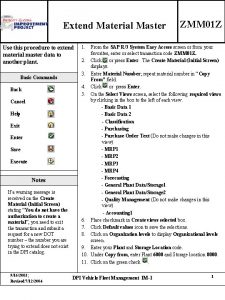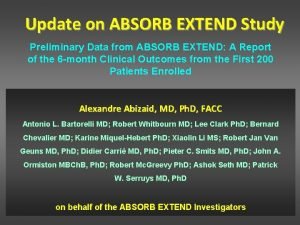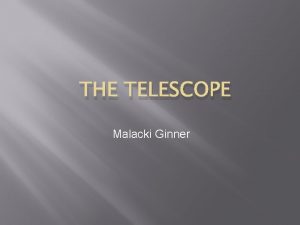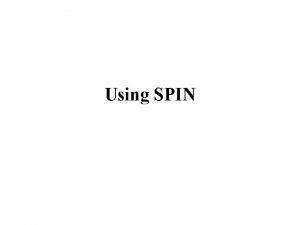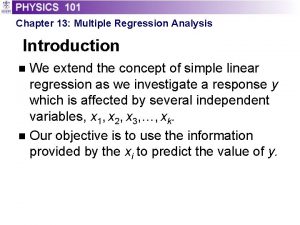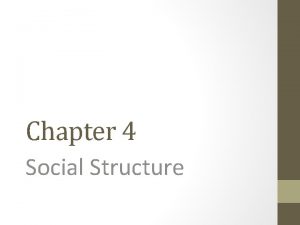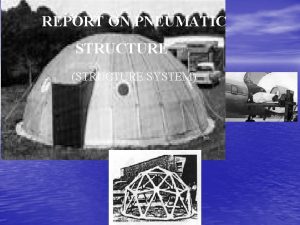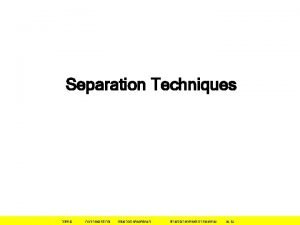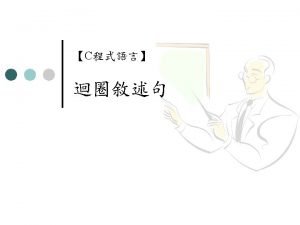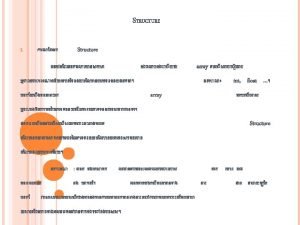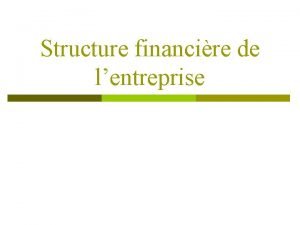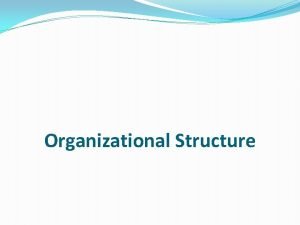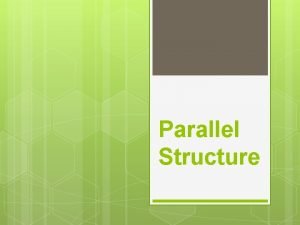Introduction To extend the study of the structure




























- Slides: 28

Introduction To extend the study of the structure of nuclei far from stability q Production of RIB's via the fission process induced - either by fast neutrons from a C converter in a UCx target goal >1013 fissions/s - or by direct bombardment of fissile material q Production of heavy ion beams for fusion-evaporation physics C D 1+ n+ UCx IS ECR Basic configuration for RIB production : high intensity D primary beam on a D-N Converter with a Carbon wheel fission fragments produced by N-induced fission of a UCx fissile target - low or high density (Gatchina) Different ion sources coupled (depending on ionization efficiency) Isotopes bred to higher charge state for proper post-acceleration Le projet SPIRAL-II, 5 octobre 2003, Porquerolles Page 1

Fission yields with converter and ~ 5 m. A primary beam. . . n d UCx 239 U Fission of Ex= 20 Me. V low density = 2. 3 g/cm 3 1013 f/s high density V = 240 cm 3 = 11 g/cm 3 5. 1013 f/s V = 240 cm 3 2. 1014 f/s V = 1000 cm 3 200 k. W dissipation in the converter 5 m. A - 40 Me. V deuteron 300 W 6 k. W (limit) power deposited in the target without converter and ~ 0. 15 m. A primary beam. . . d, 3, 4 He, . . . Fission of 240 Pu Ex≥ 50 Me. V UCx 5. 1012 f/s 6 k. W acces to a wider mass region Le projet SPIRAL-II, 5 octobre 2003, Porquerolles Page 2

Regions of the nuclear chart covered by primary beam: deuterons heavy ions 4. N=Z ISOL (thick target) 5. Transfermiums In-flight (Z=106, 108) 2. Fusion reaction with exotic beam 1 Z 1. Fission products (w/ converter) N 3. High Ex fission products (w/o converter) Le projet SPIRAL-II, 5 octobre 2003, Porquerolles Page 3

Physics with fast neutrons Material irradiation SPIRAL 2 will deliver 1015 neutrons /s peaked at 14 Me. V ideal spectrum for material studies in future fusion machines available before IFMIF and at reduced cost Pulsed neutron beam (future option) measurement of cross-sections for fission and (n, xn) reactions neutron energy inferred from time of flight technique (To. F) with 1% resolution for 10 m long beamline Le projet SPIRAL-II, 5 octobre 2003, Porquerolles Page 4

Schematic Layout α s B' V/u I R e M 6 Charge breeder 1+ / N+ CIME Source Separator deuterons m a be /G 2 t c G 1 e r Di nes li n e Id 1. 2. 3. 4. Source q/A=1/3 Q RF if t n ic io at SC n io t a st a e ar C A N LI TIS Station amp e B m p. x u n e d o i y rg ns e e t En ex l w Irradiation ia t Lo Neutrons en t o p 14 Me. V Stable ion beams Driver Target - Ion Source Station Secondary Beam Lines High Energy Radioactive Beam Lines Le projet SPIRAL-II, 5 octobre 2003, Porquerolles Page 5

α s B' V/u I R e M 6 Charge breeder 1+ / N+ Source q/A=1/3 CIME Source deuterons m a be /G 2 t c G 1 e r Di nes li n e Id io at Lo SC n io t a st ic if t n w 1. 2. 3. 4. Q RF y En g er p. x e C A N LI a e ar teur épara S : u r B B. daires n o c e s x isceau a f e d s e n nne : Lig Driver F. Vare Target - Ion Source Station Secondary Beam Lines High Energy Radioactive Beam Lines Le projet SPIRAL-II, 5 octobre 2003, Porquerolles Page 6

Facility layout Le projet SPIRAL-II, 5 octobre 2003, Porquerolles Page 7

Simultaneous beams at GANIL Multi-Faisceaux easier with direct lines CIME salles G 1 -G 2 3 séparateur 1+/n+ 1 4 5 2 Example (5 beams) SPIRAL 2 : 40 Me. V D+ onto ECS 1) Low energy RIB (LIRAT) 2) 6 A. Me. V RIB CIME VAMOS / EXOGAM Standard GANIL 3) stable beam/RIB at 50 -100 A. Me. V (CSS ’s) 4) 1 A. Me. V stable (IRRSUD) 5) 8 -10 A. Me. V stable (SME) Le projet SPIRAL-II, 5 octobre 2003, Porquerolles Page 8

Converter SPIRAL 2 PSI 200 k. W 60 k. W Diameter 1 m 0. 45 m Pradiation 53 W/cm 2 35 W/cm 2 1750°C 1527°C Pmax T max beam spot Ø 40 mm (parabolic distrib) thickness = 10 mm rotation speed < 600 trs/mn in case of C wheel failure : target protection = Carbon foil between wheel and target 70 ms to switch the beam off (time delay for 1000° to 3200°C increase) Homogeneous and Bragg model energy deposition Le projet SPIRAL-II, 5 octobre 2003, Porquerolles Page 9

Targets Geometry of the UCx target has been studied by calculating the optimum location taking into account the distribution of the neutron flux coming from the converter. 3 geometries giving > 1013 fissions/s R. Le complete effusion simulations in progress roy : Prod uctio n de s ion s rad ioact ifs 19 series of 61 disks UC 3 density 2. 3 g/cm 3 Ø 15, thickness = 1, spacing = 0. 3 Example of configuration Le projet SPIRAL-II, 5 octobre 2003, Porquerolles Page 10

Ion Sources Four types of ion sources considered for the project : § ECR ion source (gaseous elements such as the noble gases) § FEBIAD source (Forced Electron Beam for Ionization by Arc Discharge) (less volatile elements) § thermo-ionisation source (alkalis and some rare earth elements) § laser source (non-volatile elements such as metallic ones and high selectivity) prototype of ECR ion source (demanding in terms of room & auxiliary equipment) adaptation of the surface ionisation source developed at TRIUMF development of a FEBIAD prototype for pushing up the usual lifetime limitation Le projet SPIRAL-II, 5 octobre 2003, Porquerolles Page 11

Plugs Adaptation of the plug technology developed at TRIUMF Shielding of all radio-sensitive elements, like pumps (32 Sv/h at 1 m after 3 month irradiation)) Manual disconnection of the module before handling for storing or dismantling Size of biological shielding determined by dose rate calculations < 10 μSv/h at the top) (basic, complete, in the vacuum tank) Service cap Shielding plug 1. 25 m steel + 1. 50 m concrete Containment Box D-beam axis RIB axis Le projet SPIRAL-II, 5 octobre 2003, Porquerolles Shutter Valve Page 12

Plugs (2) couvercle béton passages avec câble HT Plugs nergie E Basse ECS Le projet SPIRAL-II, 5 octobre 2003, Porquerolles Page 13

Driver The driver must accelerate beams q of high power (200 k. W deuteron beam power) q different ion species and mass-to-charge ratios (deuterons as well as heavier ions of mass-to-charge ratio A/q=3 and up to A/q=6 in a later stage) q with a high output energy flexibility (from 40 Me. V deuteron energy down to low energies, as low as the RFQ exit energy) “Independently Phased Superconducting Linac” : provides a safe cw operation and high flexibility in the acceleration of different ion species and charge-to-mass ratios Short cavities: very wide velocity acceptance optimisation of the output energy for each ion specie by readjusting the RF phases of each cavity a) conservative expected from sources b) z at RFQ output Le projet SPIRAL-II, 5 octobre 2003, Porquerolles Page 14

Driver layout : reference design 0 6 m Sources + LEBT 11 m 15 m RFQ MEBT 88 MHz =0. 07 QWR (12 mod x 1 cav) 28 m 88 MHz =0. 12 40 m QWR (6 mod x 2 cav) 88 MHz Source D+ RFQ 1 Eacc = 6 -7 MV/m RFQ 2 Source q/A=1/3 Source q/A=1/6 Le projet SPIRAL-II, 5 octobre 2003, Porquerolles Page 15

D+ sources: SILHI-type & μPhoenix Water cooling UHF injection Hexapolar magnet Monogap extraction Gas injection Plasma electrode Magnet for axial field Hybrid magnet for Hexapolar and Axial field ex: Micro. PHOENIX 10 GHz norm. rms = 0. 084 . mm. mrad for 5 m. Ae D+ extracted @ 38 k. V Le projet SPIRAL-II, 5 octobre 2003, Porquerolles Page 17

Heavy Ions Sources R&D A/q=3 ion source : state-of-the-art in ECR sources: 1 m. A 18 O 6+ and 0. 2 m. A 36 Ar 12+ High confinement fields (Br 2 -3 T) and high frequency (f > 28 GHz) required Two options are explored, based on § a fully superconducting ECR source P. Sortais & D . Hitz : source s ECR § a combination of permanent and high temperature superconducting magnets European research activity “Ion Sources for Intense Beams of Heavy Ions” (ISIBHI) SERSE at LNS 14 -18 GHz PHOENIX 28 GHz Le projet SPIRAL-II, 5 octobre 2003, Porquerolles Page 18

Beam Dynamics (2) cavity aperture 1/3 Results : Øsuitable emittance growths Øsafety margin [bore radius / max beam amplitude] 1. 8 for ions 2. 5 for deuteron next step : Ø systematic start-to-end simulations including all effects and alignment errors Le projet SPIRAL-II, 5 octobre 2003, Porquerolles Page 20

Warm intertank space Quads + Diagnostics : trade-off between BD and Diag people ! Le projet SPIRAL-II, 5 octobre 2003, Porquerolles Page 21

RFQ • Accelerates in CW mode: Ø D+ beam up to 5 m. A up to 0. 75 – 1 Me. V/u Ø q/A=1/3 ions up to 1 m. A • To allow hands on maintenance: Ø 99% of transmission w/o errors Ø 97% min with all combined errors • The construction takes into account: 6. 5 m 5 m Ø Non constant voltage and R 0 profile Ø 1% on the voltage law Ø 1/10 th mm vane tips displacement Ø Minimum price Le projet SPIRAL-II, 5 octobre 2003, Porquerolles Page 22

RFQ : 4 -vane from tube and rf joints safe cw operation (lowest peak power density < 6 W/cm 2) highest transmission • Only mechanical assembly • from a low cost copper tube • Possible change of the vanes • w/o brazing nor welding RF join Le projet SPIRAL-II, 5 octobre 2003, Porquerolles Page 23

Resonators 2 IRAL P S a r p u s s ité. Olry : Cav &G G. Devanz Legnaro-type QWR Argonne-type QWR and HWR (with field asymmetry compensation) Le projet SPIRAL-II, 5 octobre 2003, Porquerolles Page 24

QWR : cavity shape optimization Goals for 8 MV/m ( E/ ) operation : lower Epk / Eacc ~ 5 → Epk ≈ 40 MV/m enlarge curvature radius of drift tube lower Bpk / Eacc ~ 10 m. T/MV/m → Bpk ≈ 80 m. T enlarge stem diameter Cavity stiffening : Stem conical shape Top rounded shape Power coupler location : Coupler mounted on removable bottom plate Electric coupling in low |H| area Qext as low as 7 104 50 ohms coaxial line Ø = 30 mm Le projet SPIRAL-II, 5 octobre 2003, Porquerolles Page 25

R&D program (1) Goal : to develop and test the most critical components to validate the chosen technology before the construction phase Provisional budget for this 2 -year R&D program = 850 k€ For the accelerator : § One RFQ module (1 meter long) test at full RF power in summer 2004 with a 88 MHz-40 k. W power source § Two 176 MHz SC resonators, one QWR + one HWR to validate fabrication, preparation and mounting procedures to compare performances of both cavity types (tests before the end of 2004) § Two high power couplers (in the range 10 -20 k. W) fabrication at the end of 2004 and test in 2005. § One 10 k. W solid state amplifier module for the SC resonators collaboration with other laboratories under study goal : prototype tested at the end of 2004 Le projet SPIRAL-II, 5 octobre 2003, Porquerolles Page 26

R&D program (2) For the target-ion source system : § Target R&D already started within a collaboration with Gatchina goal : to compare the performances of low and high density UCx targets besides, R&D on low density UCx pellets of different sizes and shapes § Design and developments of the target oven graphite oven prototypes tested to study temperature uniformity and mechanical resistance for a long operation period § FEBIAD ion source tests to demonstrate the reliability of the cathode for a long period operation § ECR ion source tests to demonstrate the feasibility of a prototype using magnetic coils Le projet SPIRAL-II, 5 octobre 2003, Porquerolles Page 27

Time-schedule for Safety Authorities Le projet SPIRAL-II, 5 octobre 2003, Porquerolles Page 28

Project organization DSM Institutes IN 2 P 3 Steering Committee TAC Technical SAC Scientific Advisory Committee Project Study Group Project Management Physics/Exp. Accelerator Target stations Beam Lines D+ Sources Ion Sources RFQ Cryomodule A/B Beam Dynamics RF Cryogenics Integration Converter Targets Ion Sources Hot Cell Plug & Handling. Separator Calculs lignes Magnets CIME post-acc. Charge booster 1+/n+ Nuclear physics, atomic, astrophysics. . Specific Techn. Conv. Facilities Safety Radiation Diagnostics Buildings Vaccum Elec. Power Control systems Power Supplies Refrig. / Fuides Waste Tech. Support Studies - Safety - Rad. shielding Documents Prep. -DOS, RPS, DAM, DAR Joint Laboratories Le projet SPIRAL-II, 5 octobre 2003, Porquerolles Page 29

Collaborations Argonne UK ? ? Gatchina Louvain ? ? Triumf LPC GSI ? ? SPR GANIL DAPNIA IRES DPII IPNO CSNSM Isolde ? ? DIF CENBG ISN CENG Legnaro Le projet SPIRAL-II, 5 octobre 2003, Porquerolles Page 30
 Intro paragraph outline
Intro paragraph outline Use case primary and secondary actors
Use case primary and secondary actors Case diagram
Case diagram Jenis relasi yang bisa timbul pada use case diagram kecuali
Jenis relasi yang bisa timbul pada use case diagram kecuali Include and extend in use case
Include and extend in use case Leg rotation muscles
Leg rotation muscles What is extend in use case diagram
What is extend in use case diagram Interface oop
Interface oop Semitendonosis
Semitendonosis Python append vs extend
Python append vs extend Include extend use case
Include extend use case Relacion de inclusion
Relacion de inclusion Retrocollis
Retrocollis Electric field lines about a point charge extend
Electric field lines about a point charge extend Renpy games
Renpy games Isstatisticsui.lua
Isstatisticsui.lua Casos de uso include
Casos de uso include This line shows the starting and ending of dimension
This line shows the starting and ending of dimension Include extend use case
Include extend use case Scenariusze przypadków użycia
Scenariusze przypadków użycia Employers must not place construction loads
Employers must not place construction loads Handles on these must not extend beyond
Handles on these must not extend beyond Banks extend many fixed-rate loans
Banks extend many fixed-rate loans Cpick download
Cpick download What are the outputs of the sign-extend and the jump
What are the outputs of the sign-extend and the jump How does newton's law of gravity extend kepler's laws
How does newton's law of gravity extend kepler's laws Dog hand signals chart
Dog hand signals chart Embrace extend extinguish
Embrace extend extinguish Sơ đồ use case hệ thống atm
Sơ đồ use case hệ thống atm

